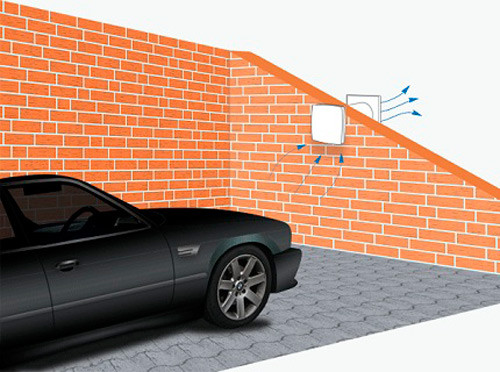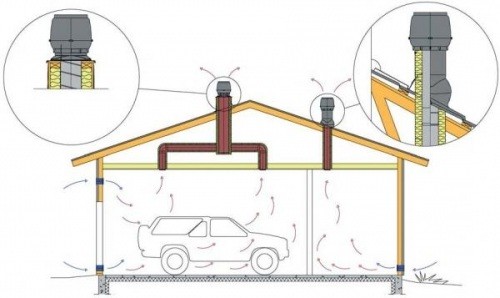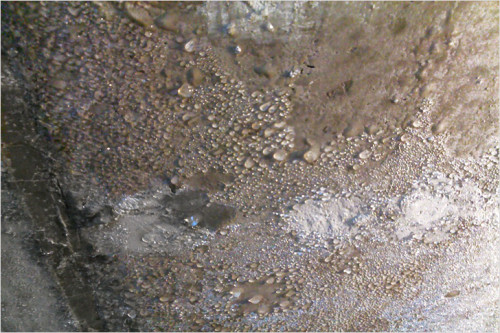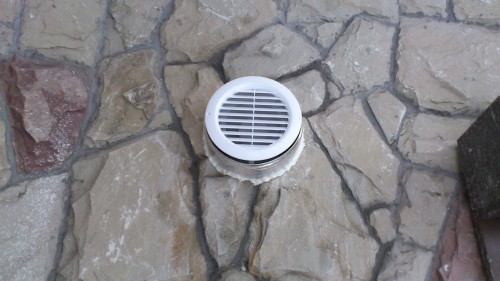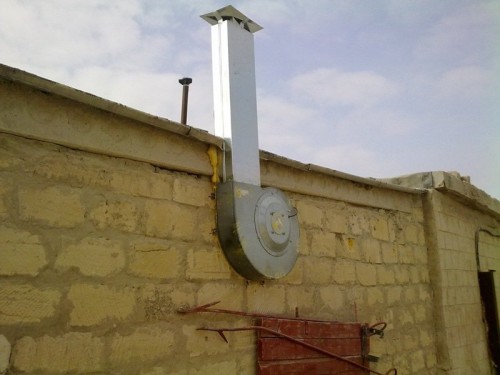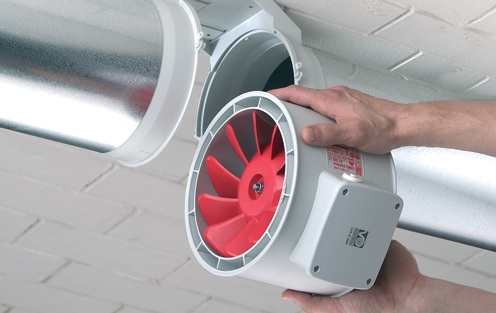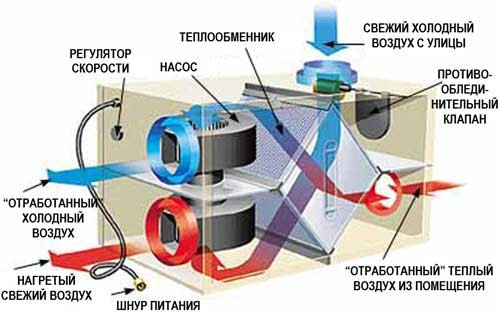If you gathered to buy a car, you need to immediately take care of the acquisition of the garage for her. Otherwise, the technician will serve much less time than it is supposed. In turn, the garage should not be just a box for temporary maintenance of the car, but serve a full protection against weather and attackers, to be a convenient place to repair. The priority requirements include high-quality thermal insulation, moisture protection and creating a good ventilation system. In this article we will talk about the last, and you will learn how to make ventilation in the garage.
Ventilation device
There are several ways to organize the ventilation system in general and in garages in particular, but before you describe each of them, it is worth talking about the features of the air exchange in the garage. Since this is a special room for the maintenance of the car, they are presented to it. Fresh air must continue in a minimum of 180 l / h. This rule was established in Soviet times, but still operates throughout the post-Soviet space, while in Western countries this standard has already risen to a minimum mark of 360 l / h. And if you consider the fact that the imported "western" machines on the streets are much more than auto products of domestic production, one can boldly be repeated in the calculations from 360 l / h.
So, in the garage you can equip one of the following ventilation systems:
- Natural - the replacement of dirty air pure is completely natural. Clean air penetrates the garage through the pipe, the outlet of which is located near the floor, in the process of pollution, it heats up and, obeying the laws of physics, rises up to the hole of the exhaust pipe located under the ceiling on the opposite side of the garage. The newly air incoming passes are pushing the spent, and he leaves the garage alone. The movement of air flows is carried out due to convection and temperature drop from the outside and indoors. From this, the main disadvantage of natural ventilation of the basement and the garage - when the temperatures are compared, which is often in the summer, air movement will stop.
- Forced - this type of ventilation system will work with any weather and temperatures, however, it will require an electrical connection. The fact is that the movement of the air masses in this case is carried out through the operation of special fans installed at the ends of the air ducts. One fan sucks clean air outside, the second pulls the exhaust air out of the room. As a result, the air exchange occurs much faster, which allows you to establish forced ventilation even in large garages for several cars. The disadvantage is the need for equipment from the network, as well as the cost and complexity of installing this equipment itself. Newbie to construct, calculate and put forced ventilation will be quite difficult.
- Combined - according to many specialists, is the most optimal version of the ventilation system for all occasions. It combined the advantages of the two of the above systems and practically devoid. So, according to the organization, it completely coincides with natural ventilation, but on one of the air ducts there is a fan, which creates a craving in the case of a natural stop of the movement of the air masses. Instead of a fan or together with him, many use special deflectors. These are special windmills, which are installed on the end of the intake tube, located outside, and they like the floods catch the gusts of the wind and pushed inside clean air. Deflectors allow you to save electricity and ensure uninterrupted drawing in the garage.
It is necessary to start the arrangement of any ventilation in the garage with their own hands. To do this, you need to know the specifics of the room and its area. Then it can be calculated, the air ducts with which cross section will be required and how much air will need to be replaced per unit of time. In most cases, the following ratio is used: 1 m² of space requires 15 mm of the duct section. So for a garage of 5x6 m, air holes are needed with an area of \u200b\u200bat least 450 mm². Pay special attention to the design of the exhaust and air volumes that need to be replaced. So, if there is no need to make a powerful hood, you should not spend money on the purchase of an expensive system of forced ventilation - you can do the combined system with a deflector. Also for convenience, it is recommended to install seats or shut-off blinds to control the power of air flow.
Useful advice: So that the system worked smoothly, insulate the air ducts with foam, foamizol, mineral wool or other thermal insulation material. Otherwise, due to the temperature difference, condensate can accumulate on the inner walls of the pipes, which will stop in the winter and scores the pipe.
The danger of condensate
It affects the choice of the ventilation system not only the area of \u200b\u200bthe garage, but also its type. So, if the metallic or stone garage does not heal, there will inevitably appear and accumulate condensate. But in our case, it is not dangerous for the availability of water on the interior walls, but the fact that it collects toxic particles of exhaust gases and various chemicals that are in the air. Over time, the concentration of them accumulates, the "poisonous" condensate is settled by car and can damage the skin, not to mention the fact that being in such a room will be harmful to health. To prevent such a situation, it is necessary to build at least the simplest natural ventilation.
If there is a cellar or observation pit in the garage, in winter, the temperature inside will always differ from the temperature outside, which is explained by the physical characteristics of the soils. And we already know that consequence of such temperature drops is condensate. However, natural ventilation will not cope with ventilating and basement with the pit, and the garage premises, therefore will be rationally apply a forced or combined scheme.
How to make ventilation in the garage
Any ventilation system assumes the presence of at least two holes: inlets and exhaust. After the work of the calculations, it is necessary to purchase air ducts of the corresponding section. For this, asbestos-cement, metal galvanized or polyvinyl chloride pipes can be used. The easiest way is the cutting of the ventilation holes on the opposite sides of the garage and the overlap of them with lattices. Place Ventskanals at maximum removal from each other so that the exhaust air can be replaced clean in full. Make the supply hole at the bottom of the gate or the front wall of the garage, and exhaust output over the roof. To do this, it will be necessary to vertically install the pipe, insulate it and equip it with a deflector to improve the efficiency of work and reduce heat loss.
Natural ventilation is the easiest and most cheap of all other schemes. It is quite simple to make it: at the bottom of the garage gate, the supply grilles made of fine-mesh mesh are embedded, so that dirt, insects or animals do not fall inside. On the opposite wall inside the garage, 1.5-2 m from the floor level make the exhaust grille or install the pipe. To know how to make natural ventilation in the garage correctly, you need to follow simple rules. First, make the supply holes 2-3 times more exhaust and place them about 10 cm from the floor level. Secondly, the exhaust hole should always be placed above the level of the intake minimum of 1.5 m (ideally 2-3 m). If you do ventilation in the cellar, output the exhaust air duct into the street and raise it above the ground level by less than 50 cm so that there is a good traction. Thirdly, try to place the supplied and exhaust holes clearly diagonally on opposite sides of the room.
To create combination ventilation, you will have to spend a little more money, but the level of installation complexity will be no higher than in the case of a natural scheme. All the difference is to insert the fan into the trim duct. Pay attention to the position of the fan - it must suck clean air from the street, and not the opposite! If you don't like the idea with a reinforced fence with clean air, you can put a fan on the exhaust pipe, then it will faster pulling out the exhaust gases outside. In any case, a stable thrust will be created, which improves the functionality of the system. It should be taken into account that for the combined system there is one limit regarding the location of the supply and exhaust holes: in no case should they do on one line opposite each other, and should be placed on the diagonal. The force of thrust also depends on the power of the fan used. You can find out this parameter yourself, looking at the corresponding SNiP or depending on the size of the room. At the beginning of the article, we have already said that SNiP designed in the times of the Soviet Union, it states that the volume of air intake should be at least 180 l / h, but since most of the car owners prefers to use the products of Western production, logically adhere to the Western standards - 360 l / h. Alternatively, you can calculate the power of the fan in terms of the room. In the case of the garage, it is best if the air is completely changed to 5-7 times per hour. So, find the garage volume, multiplying its height, width and length, then multiply the resulting value of the garage air exchange, equal to 5 and get a number that will mean the recommended fan performance per hour.
For efficient operation of the system, it is important to correctly calculate the diameter of the air ducts and make the trim and exhaust opening of equal size. If combined ventilation is equipped with a mechanical influx, a natural extract will be required, which would cope with the incoming air volume, and vice versa.
How to make ventilation in the garage cellar? In this case, the underground space will be needed, and the room itself, where the car is located. If you put the fan and on the influx, and on the extractor, the ventilation of the forced type, and the movement of air masses in the room will be constant and strong. The main disadvantage of a fully mechanized system is that the air, continuously coming from the street, will be quite cold in winter, and all efforts to heat insulation will be reduced to zero. Therefore, if there is no other way out, how to equip forced ventilation, no, it is recommended to equip the system to heat the air with a recuperator. The recuperator is a device in the form of a monoblock through which the fence and exhaust air duct passes. The heat of heated air, which leaves the garage, is transmitted to it incoming inside with pure cold air.
Such recovery systems are able to completely replace heating, saving the means for heating the room. Of course, their cost and installation will fall out, but this is the optimal option for large garages for several cars. In addition to the recovery, the design includes many other components: air filters, sensors, etc.
When choosing a way to make ventilation properly in the garage, you must first of all to be repelled from the financial capabilities, the presence of the power grid and the parameters of the room. The correct calculations play a big role in the efficiency of the system. In most cases, it is possible to "get rid of small blood", equipping the simplest natural system, but if you notice that it does not cope, do not pull with modifications and the transformation so as not to harm neither a car or your own health.
Finally, we suggest see a useful video, how to make ventilation in the garage:


